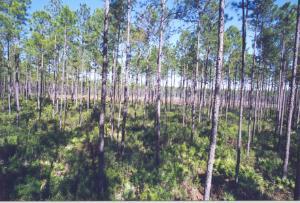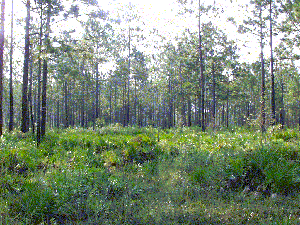Growth and Yield
Predicting the future growth and yield of your forest stand(s) is an essential part of the planning process for your forest land. This page will provide you with a basic understanding of the concepts of growth and yield. A look at these concepts in the context of even- and uneven-age stand structure will also be provided.
Trees accumulate woody material (branches, bole, roots) over many years, a layer per period or year. Like people, trees do not grow according to a standard form, they grow short and thick, tall and slim, and everything in between.
Growth is measured as change in some characteristic (weight, basal area, volume, etc.) over some specified amount of time. For example, let's say your stand of slash pine might increase in volume by 2,000 cubic feet over 10 years. If we state this as an annual increment, we would say that the stand's growth is equal to 200 cubic feet per year (2,000 cubic feet per year / 10 years).
Yield actually has 2 meanings. It is:
- the amount of some characteristic that can be harvested per period, or
- the total amount that could be removed at any time
In our slash pine example, an average of 200 cubic feet could be harvested from the stand each year, or 2,000 cubic feet could be harvested after 10 years. If this yield was equal to the growth and could be continued at that level, we would say that your stand was under sustained yield management.
Another commonly used measure of growth and yield is the cord or cords per acre. A cord is 128 cubic feet of stacked roundwood (whole or split, with or without bark) containing wood and airspace, with all the pieces of similar length and lined up on approximately the same direction. Example: a pile of firewood 4' x 4' x 8'.
Generally, the maximum amount of output that a forest or stand can yield at any time is the growth that has accumulated up to that time, and the maximum yield that can be removed in perpetuity per period equals the growth of that forest or stand per period.
Growth and yield can be measured in physical units or in value, often the variable of interest. Since physical measures form the basis of value measures, we will focus on the physical measures here.
-
Types of Growth Increments
The first step in measuring growth is to establish the smallest tree to be measured and count as a contribution to growth. This is commonly defined as the minimum size that is merchantable*.
- *merchantable tree: one that can be harvested and manufactured into products.
For example, merchantability can be stated like this:
- all trees that will provide at least one 16-foot log to an 8-inch top diameter; all trees 11 inches and larger DBH* are assumed to meet this requirement.
- *DBH: diameter at breast height, or 4.5 feet from highest ground at the base of the tree.
Let's say that we want to measure the growth of our stand between two successive inventories. The measurements that we will need include:
- Ingrowth
This is the volume of new trees growing into the minimum measurable size class during the measurement period. For this you need the diameter and height of the trees that have grown into this diameter class. - Mortality
This is the volume of measurable trees dying during the measurement period. - Cut
This is the volume of timber removed during the measurement period.
Combining these three measures of stand change with the volume of living trees at the beginning and end of the measurement period will give us the components we can use to estimate stand growth. These components include:
V1 = volume of living trees at beginning of measurement period
V2 = volume of living trees at end of measurement period
M = volume of mortality over period
C = volume cut over period
I = volume of ingrowth over periodUsing these components, we can calculate five measures of increment over the growth period:
- Gross increment including ingrowth = V2 + M + C - V1
- Gross increment of initial volume = V2 + M + C - I - V1
- Net increment including ingrowth = V2 + C - V1
- Net increment of initial volume = V2 + C - I - V1
- Net change in growing stock = V2 - V1
-
Stand Growth
In the long run, we cannot cut more than we can grow. For this reason, predicting stand growth occupies a large portion of many foresters' efforts. The methods used to predict and describe the growth of a stand depend in part on the silvicultural system used. The two broad categories of silvicultural systems are even- and uneven-aged.
Even-aged Stands
 In an even-aged silvicultural system, all trees are initiated at the same or roughly the same point in time. While tree sizes increasingly vary as the stand ages, the calendar age of all the trees is about the same. Even-aged stands have definite beginnings and endings, and therefore are relatively simple to conceptualize and schedule for cultural treatments and harvest. Most even-aged stand characteristics are related to stand age. These relationships guide our decisions about when to treat or harvest the stand.
In an even-aged silvicultural system, all trees are initiated at the same or roughly the same point in time. While tree sizes increasingly vary as the stand ages, the calendar age of all the trees is about the same. Even-aged stands have definite beginnings and endings, and therefore are relatively simple to conceptualize and schedule for cultural treatments and harvest. Most even-aged stand characteristics are related to stand age. These relationships guide our decisions about when to treat or harvest the stand.The typical lifeline of an even-aged stand is:
- stand initiation (plant or seed)
- a series of intermediate treatments (vegetation control, fertilization, thinning)
- harvest
- initiate a second rotation
See our Timber Management page for more information about even-aged forest management.
 Uneven-Aged Stands
Uneven-Aged Stands Uneven-aged stands generally lack a definite beginning or end in time. Trees on any given acre of an uneven-aged stand vary by age, size, and end in time. Management of this type of stand is basically a periodic cycle of partial harvests which influence the species composition and size structure of the residual stand. Traditionally, new trees of uneven-aged stands originate from the seeds or sprouts of the mature trees and grow in the shade of older trees or in small openings. Underplanting is sometimes used to achieve more desirable production.
The interval between harvests in an uneven-aged stand is called the cutting cycle. A cycle starts with a harvest that leaves a specified volume of reserve growing stock. This volume grows for the number of years in the cycle. A harvest cut removes the merchantable portion of this growth, plus or minus whatever adjustments are desired in the reserve growing stock to initiate the next cycle.
See our Uneven-aged Forest Management page for more information.
Forest Management
- Forest Management Overview
- Fire
- Florida Silviculture BMPs
- Forest Certification Programs
- Forest Inventory
- Forest Management Plan
- Other Forest Values
- Technical & Cost-share Assistance
- Timber Management
- Uneven-aged Management
- Vegetation Management (Southern Regional Extension Forestry link)
- Wildland-Urban Interface

